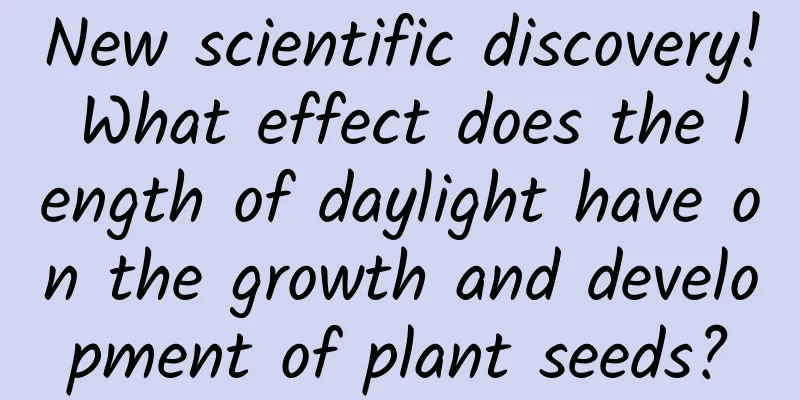New scientific discovery! What effect does the length of daylight have on the growth and development of plant seeds?

|
Produced by: Science Popularization China Author: Hu Yilong (South China Botanical Garden, Chinese Academy of Sciences) Producer: China Science Expo The philosopher said that there are no two identical leaves in the world. Botanists say you will never find two seeds that are exactly the same. Seeds of different species vary greatly in appearance, size, color and nutritional content, and seeds of the same species also vary. The reasons for these changes are environmental changes and genetic mutations. Among these differences, the most intuitive one is the size of the seeds. Even if you have no farming experience, if you put two different seeds in front of you, I think you will be able to judge that the one with big and full seeds is the good seed! During the thousands of years of crop domestication, the artificial domestication of several major food crops, including rice, soybeans, and corn, all experienced a process of seeds growing from small to large. In addition, the nutrients in the seeds provide energy for seed germination. Large and full seeds can germinate better, thus ensuring the smooth inheritance of life. So how can we cultivate large, plump, high-quality seeds? Ripe wheat ears in the field (Photo source: Veer Gallery) Photoperiod as a growth regulator for plants The rotation of the Earth brings about the alternation of day and night in a day, while the revolution of the Earth around the sun brings about the change of the length of daylight throughout the year. This alternation of the length of light and dark periods within 24 hours a day is called the photoperiod. The photoperiod is the most stable environmental factor in nature. The summer solstice and winter solstice are the two days with the longest and shortest light durations, respectively. Organisms on Earth can sense seasonal changes through the photoperiod and complete their growth, development and reproduction in the most suitable season. People also carry out various agricultural production activities according to the changes of the four seasons. In agricultural production, people are most concerned about the response of plant flowering time to photoperiod . According to the length of daylight that induces flowering, plants can be divided into long-day plants that induce flowering in long days, short-day plants that induce flowering in short days, in addition to medium-day plants, and day-neutral plants that are insensitive to photoperiod. Over the years, people have had a relatively clear understanding of the effects of photoperiod on plant flowering and the molecular mechanisms behind it, but how it affects post-flowering development, especially seed development, remains unclear. However, by analogy with previous studies on flowers and photoperiods, an idea emerged: Can seed growth also be regulated according to different lengths of daylight? From seed to sprout (Photo source: Veer Gallery) How do seeds grow big and full? It has something to do with sunlight, but it doesn't have to be exposed to the sun all the time! In fact, the seed size of plants is indeed closely related to the photoperiod. In recent years, the research team of Hu Yilong/Hou Xingliang from the South China Botanical Garden of the Chinese Academy of Sciences has focused on the study of plant seed development. Starting from the perspective of how environmental factors affect the size of plant seeds, they discovered the universal law that the length of daylight (photoperiod) affects seed size. Through research, we not only discovered the relationship between photoperiod and seed size, but also found the gene that responds to photoperiod in plants - the CO gene. So, how was the specific experiment conducted? First, the researchers selected two types of plants with representative photoperiod characteristics for study, namely the long-day plants Lotus japonicus, pea and Arabidopsis thaliana and the short-day plants soybean, adzuki bean and phaseolus vulgaris. In fact, just by looking at the categories to which these plants belong, it is not difficult for us to make such a guess: Is it that long-day plants prefer the sun and can grow plump seeds under long-day conditions, while the opposite is true for short-day plants? Indeed, by observing the seed size of these plants under different photoperiod conditions, the researchers found an interesting phenomenon with a universal law: the seeds produced by three long-day plants (Lotus, pea and Arabidopsis) under long-day conditions are larger than those under short-day conditions, while the seeds produced by three short-day plants (soybean, adzuki bean and kidney bean) under short-day conditions are larger. Now, we know that different plants have different suitable light periods for growth. So the question is, what mechanism is at work in plants that makes some plants love the sun and some plants don't love it so much? Subsequently, the researchers conducted in-depth research on the long-day plant Arabidopsis thaliana and found that the photoperiod response factor CO gene played a key role in it. When the CO gene mutated, the plant produced seeds of the same size under different photoperiods. It turns out that it is the role of the CO gene that makes plants respond differently to different photoperiods. Later, through bioinformatics, genetics, molecular biology and other methods, researchers found that the CO gene directly inhibits the transcription of transcription factor AP2 and regulates seed size in a photoperiod-dependent manner. Further cell morphological observation and analysis found that the CO gene affects seed size by increasing the number of epidermal cells in the seed coat. Among them, there is another interesting discovery. The researchers found that only the CO gene from the mother has the function of regulating seed size, while the gene from the father has no effect on seed size. Not only does the CO gene in Arabidopsis have such a regulatory function, but the researchers also further verified that the CO gene has similar functions in the crop soybean. The role of CO gene in photoperiod-induced seed development (Image source: Reference [1]) Conclusion Now we know that photoperiod has a direct regulatory effect on seed development, and the CO gene plays a core role in this process. As the old saying goes, everything grows with the help of the sun. The sun provides light and heat, and plants also rely on the sun to sense the change of seasons. Some plants may love the sun more, while others may not love it so much. If we understand the direct impact of environmental factors on seed development, then we will be more likely to adapt to local conditions and cultivate better quality and fuller seeds, and then cultivate stronger and more productive crops, so as to achieve "food in hand, no panic in heart". References: [1] https://www.nature.com/articles/s41477-023-01350-y Editor: Guo Yaxin |
Recommend
Does antimatter really exist? How expensive is it? Will it be used by bad guys to destroy humanity?
I have talked about the issue of antimatter many ...
How to carry out refined promotion of mobile advertising?
What is mobile advertising? Mobile advertising re...
More than 60 tools for event operation and promotion, a must-have!
To organize a good event, it often goes through t...
Internet finance, how to quickly acquire a large number of real target users?
“Just like true love, you never need to chase aft...
How to do data reporting in operations? Here are 6 tips for you!
As the saying goes, a picture is worth a thousand...
Online education APP operation: How to motivate users to complete course learning?
In an era where mobile Internet is so popular, mo...
How to create highly sticky products? Teach you 3 models
What is CLV? You must understand this word when m...
Toutiao | Only open to small and medium-sized advertisers, how good is the conversion rate of the CPA model?
The conversion cost is sometimes high and sometim...
WeChat has secretly launched a new feature! Have you discovered it?
A good product is one that is constantly updated ...
Operational Strategies for Internet Finance Users (I)
There are three articles in the series "Touc...
SAIC Motor delivered 750 “government reception vehicles” to the CIIE
(October 12, 2024, Shanghai) Today, the "Del...
Detailed explanation of Windows 10's Wi-Fi sharing feature
Ever since Windows 10 officially debuted last wee...
The most comprehensive guide to campus promotion activities!
Today I will share with you the most comprehensiv...
[Creative Cultivation Program] One cockroach can reproduce 10 million? Why are cockroaches so fertile?
How terrifying is the reproductive ability of coc...
What keeps users in your product?
Introduction I once used a canvas belt for six ye...









